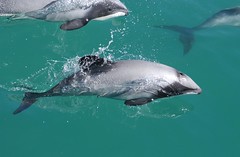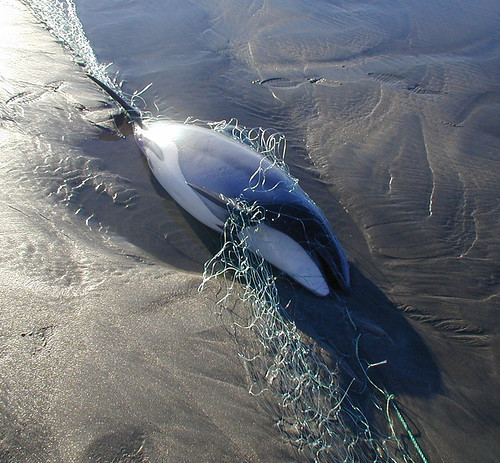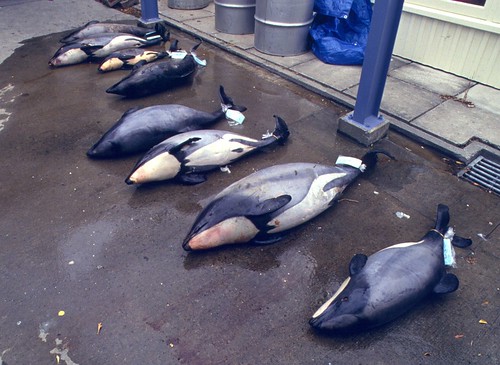紐西蘭極度瀕危的毛伊海豚,是全世界最小也最稀有的海豚,目前數量再跌至43至47隻的新低,成年母海豚只剩10到12隻。鯨豚專家和保育人士警告,這樣下去,毛伊海豚將在15年內絕種。
毛伊海豚。攝影:S. Dawson;來源:NABU。
瀕危毛伊海豚 最新族群數將公布
國際捕鯨委員會(IWC)科學委員會的年度會議將於聖地牙哥舉行,毛伊海豚的未來屆時也將是全球200位鯨豚科學家的討論重點。毛伊海豚專家、紐西蘭奧塔哥大學動物學家Liz Slooten將在會議上報告毛伊海豚最新的族群數量。
Slooten和其他海豚專家與保育人士警告,除非立即增加漁業保護機制,否則毛伊海豚將在15年內絕種。
NABU國際自然保育基金會會長Thomas Tennhardt指出,「紐西蘭政府推卸保育毛伊海豚的責任。3年來,IWC科學家不斷要求紐西蘭政府禁止在毛伊海豚棲地使用流刺網和拖網。不過紐西蘭仍忽略科學家的要求,還為了短期經濟利益出賣了棲地。」
小到可以放在浴缸 也最易受人類威脅
 |
| 毛伊海豚。來源:NABU。 |
毛伊海豚是赫氏海豚的亞種,只生活在紐西蘭北島東岸的淺海。
赫氏海豚和毛伊海豚是全世界最小的海豚,小到可以放在浴缸裡。牠們也是唯二背鰭是圓形的海豚,行為模式和有限的分佈區域都跟其他海豚不同。
赫氏海豚和毛伊海豚喜歡生活在100公尺以內的淺海,因此容易受到刺網、資源開發和漏油等人類活動的影響。
1970年代起,毛伊海豚的數量因為捕魚活動的關係減少97%。2004年只剩下111隻,2010年只剩59隻。刺網禁用範圍僅佔毛伊海豚棲地不到20%,拖網禁用則不到5%,毛伊海豚仍不斷被意外捕撈上岸。
環團:棲地應全面禁漁、禁開發行為
為了拯救毛伊海豚,紐西蘭非營利皇家森林與鳥類學會建議,應全面禁止棲地捕魚、海洋採礦和地震勘探。
毛伊海豚的生存危機沒有間斷過。
澳地利OMV石油公司2月20日在紐西蘭北島西岸外海發生漏油,300公升的原油在毛伊海豚棲地30公里外漏出。OMV則聲稱會在漏油散佈10公里範圍內清除完畢。
NABU國際自然保育基金會主席Thomas Taha指出:「這是OMV在5年內第3次漏油。因此我們要求紐西蘭政府禁止在敏感海域鑽油。」
毛伊海豚棲地內外周邊的地震探勘和採礦活動越來越多,讓牠們的處境雪上加霜。現在又有一座新的潮汐電廠計畫設在毛伊海豚僅剩的棲地內。
海鮮產業工會反保育 堅稱無立即生存危機
紐西蘭海鮮產業協會等工商代表,卻反對任何保護毛伊海豚的作為。他們多次和政府對簿公堂,就為了推翻更多保護條例。
不管有多麼充足的證據,紐西蘭漁業仍堅持赫氏海豚和毛伊海豚沒有立即生存危機。
毛伊海豚繁殖數量很慢。母海豚要到7歲以上才會開始生育,每2~4年才會生一隻小海豚。毛伊海豚壽命約20年,一生中生育數量很少,最大族群成長率僅2%,也就是說,族群數量少於50隻的話,要超過一年才會增加一隻個體。
不過NABU國際自然保育基金會說,如果可以確實保護僅剩的毛伊海豚,仍有復育機會,「若沒有人為致死因素,可以在87年內數量達到500隻。」
毛伊海豚。攝影:S. Dawson;來源:NABU。
Numbers of the world’s smallest and rarest marine dolphin, New Zealand’s critically endangered Maui’s dolphin, have hit an all time low of 43-47 individuals, with just 10-12 adult females.
Cetacean experts and advocates are warning that the Maui’s dolphin could go extinct within 15 years.
The future of the Maui’s dolphin will be part of the discussions by 200 of the world’s cetacean scientists who are in San Diego for the annual two-week-long meeting of the Scientific Committee of the International Whaling Commission, IWC.
Maui’s dolphin expert Associate Professor Liz Slooten, with the Department of Zoology, University of Otago, New Zealand, will present the latest population figures to the IWC Scientific Committee.
She and other dolphin experts and advocates are warning that unless the level of fisheries protection is increased immediately, Maui’s dolphins could become extinct in 15 years.
Maui’s dolphins are a subspecies of Hector’s dolphins and occur only in shallow coastal waters off the west coast of New Zealand’s North Island.
Hector’s and Maui’s dolphins are among the smallest dolphins in the world, small enough to fit in a bathtub. They are the only dolphin species with a rounded dorsal fin, and are also distinguished from other dolphins by their behavior and limited distribution.
Hector’s and Maui’s dolphins prefer to live in waters less the 100 meters deep, which makes them vulnerable to human activities such as fishing with gill nets, resource exploitation, and oil spills.
毛伊海豚。攝影:S. Dawson;來源:NABU。
Thomas Tennhardt, president of NABU International Nature Conservation Foundation, says, “New Zealand has so far shirked its responsibility to protect the last Maui’s dolphins. For three years running, IWC scientists have urged the New Zealand government to ban the use of gillnets and trawling across their entire habitat. But New Zealand has stubbornly ignored the scientists and is selling out this rare species for short sighted economic reasons.”
In order to save Maui’s from extinction, the New Zealand nonprofit Royal Forest & Bird Society is recommending full protection from all threats: fishing, marine mining and seismic surveying in the areas that they inhabit.
Threats to the Maui’s survival are constant. An oil spill caused by the Austrian oil company OMV off the West coast of New Zealand’s North Island on February 20 threatened the few remaining Maui’s. Some 300 liters of crude oil were released about 30 km from the waters inhabited by the Maui’s dolphins. According to OMV, the spill spread to cover 10 km of ocean waters before it was cleaned up.
“It is the third oil spill caused by OMV in this area already in just five years,” said Thomas Taha, who chairs the NABU International Nature Conservation Foundation. “We therefore call on the government of New Zealand to prohibit oil production in sensitive marine waters.”
Since the 1970s, Maui’s dolphin numbers have dropped by about 97 percent as a result of fishing. By 2004, there were 111 Maui’s dolphins, and by 2010 the population had slipped to 59.
Because protection from gillnets extends over less than 20 percent of Maui’s dolphin habitat and less than five percent for trawling, dolphins continue to die in fishing nets as bycatch.
Industry bodies, such as the New Zealand Seafood Industry Council, have opposed every effort to improve the protection for these animals. They have taken the government to court on several occasions in an attempt to overturn more protective regulations.
Despite overwhelming evidence, New Zealand’s fishing industry still holds that, “…no immediate crisis exists for either Maui’s or Hector’s dolphins.”
An upsurge of seismic surveys and fossil fuel extraction in and near the Maui’s dolphins’ home waters further increase the risks for this small and declining population.
Now a massive tidal power station is planned in key habitat of the last few Maui’s dolphins.
But if these beleaguered dolphins could be protected from humans they could still recover and thrive, says NABU. The absence of deaths caused by human activities “would set Maui’s dolphins back on the road to recovery and allow numbers to grow to 500 individuals in 87 years,” the group said in a statement.
But reproduction is slow for Maui’s dolphins. Females don’t breed until they are at least seven years old and only give birth to a single calf every two to four years.
With a life span of up to 20 years, mothers can only raise a small number of calves.
Maximum population growth for this species is just two percent. This means that a population of less than 50 can increase by fewer than one dolphin a year.









